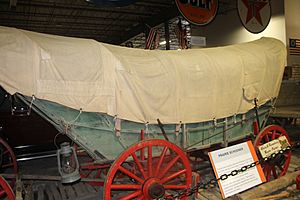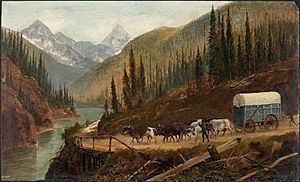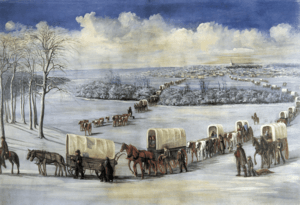Covered wagon facts for kids
A covered wagon was a special vehicle. It was mostly made from wood and canvas. People used these wagons for travel, especially in the 1800s in America. They were like the "SUVs" of their time!
These wagons were inspired by the strong Conestoga wagon. That wagon was built for rough roads in early America. But the Conestoga was too heavy for long trips west. So, people started covering their regular farm wagons. These covered wagons became very important. They were used on famous routes like the Oregon Trail and Santa Fe Trail. Settlers used them to find new land, gold, and a fresh start in the American West.
Over time, the covered wagon became a famous symbol. It represents the exciting history of the American Old West.
Journey to the West: Covered Wagons
After crossing the Appalachian Mountains, settlers found flat, fertile land. This area between the Appalachians and the Mississippi River was quickly settled. In the mid-1800s, thousands of Americans moved west. They used many kinds of farm wagons. They traveled across the Great Plains to places like California, Oregon, and Utah.
To make a covered wagon, people added wooden or metal arches. These arches went high over the wagon's bed. Then, a strong canvas or cloth was stretched over the arches. This created the unique shape of the covered wagon.
People sometimes called these wagons "prairie schooners." This was a fun nickname! It came from their large white canvas covers. These covers looked like the sails of a ship. It was like they were sailing across the vast "sea" of the prairie.
For people moving west, covered wagons were the most common way to travel. They were used more often than stagecoaches or trains. Oxen were usually the animals that pulled these wagons. But mules and horses were also used. Guidebooks for travelers often said that oxen were the best choice. They were reliable, cost less, and were almost as fast as other animals.





